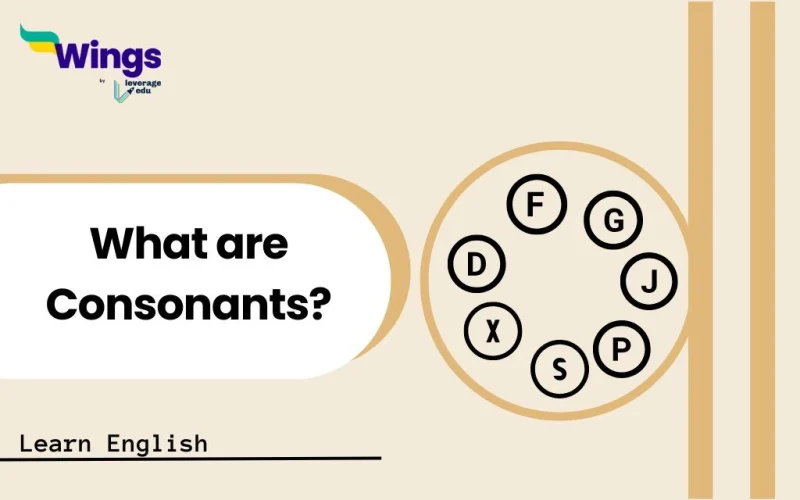What are Consonants? Consonants are speech sounds produced by obstructing the airflow in the vocal tract, using the tongue, teeth, lips, or palate. Unlike vowels, which have an open sound flow, consonants involve partial or complete closure of the vocal passage. In the English alphabet, consonants are all the letters except A, E, I, O, and U (the vowels). Examples of consonants include B, C, D, F, G, and so on.
Keep reading this blog as you will get to know what are consonants, their classifications along their significance in English communication.
This Blog Includes:
What are Consonants?
What are Consonants? A consonant is a speech sound that is articulated with a complete or partial closure of the vocal tract. This obstruction can occur at various points in the mouth, such as the lips, tongue, or throat. Unlike vowels, which allow for an open flow of air, consonants involve some degree of restriction in airflow.
In English, there are 21 consonant letters: B, C, D, F, G, H, J, K, L, M, N, P, Q, R, S, T, V, W, X, Y, and Z. The letter “Y” can function as both a consonant (as in “yellow”) and a vowel (as in “gym”) depending on its context within a word.
Importance of Consonants in English Language?
Consonants play a vital role in language for several reasons:
- Word Structure: They combine with vowels to form syllables and words. For instance, in the word “cat,” the consonant sounds (/k/, /t/) work with the vowel sound (/æ/) to create meaning.
- Clarity and Distinction: Consonants help differentiate words that may otherwise sound similar. For example, “bat” and “pat” differ only by their initial consonant sounds.
- Phonetic Variety: The variety of consonant sounds enriches language and allows for diverse expression.
Also Reads: What are Vowels?
Consonant Sounds In English
The English language has 24 consonant sounds, which can be categorised into voiced and voiceless pairs. Voiced consonants are produced with the vibration of the vocal cords, while voiceless consonants do not involve this vibration.
Following are the examples of consonant sounds for you:
| Sound | Example Word |
| /p/ | pat, cap |
| /b/ | bat, cab |
| /t/ | top, cat |
| /d/ | dog, mad |
| /k/ | cat, kite |
| /g/ | go, big |
| /f/ | fish, leaf |
| /v/ | van, love |
| /θ/ | think, bath |
| /ð/ | this, mother |
| /s/ | sun, kiss |
| /z/ | zoo, buzz |
| /ʃ/ | shoe, rush |
| /ʒ/ | measure, vision |
| /tʃ/ | church, match |
| /dʒ/ | judge, age |
| /m/ | man, summer |
| /n/ | no, ten |
| /ŋ/ | sing, ring |
| /l/ | light, bell |
| /r/ | red, car |
| /w/ | water, win |
| /j/ | yes, yellow |
Also Read: Games to Improve Vocabulary for Beginners and Pros
Consonants vs Consonance
Let us now understand the difference between consonants and consonance.
Consonants
Consonants are speech sounds that are articulated with a complete or partial closure of the vocal tract. In the English language, there are 21 consonant letters: B, C, D, F, G, H, J, K, L, M, N, P, Q, R, S, T, V, W, X, Y, and Z. Notably, the letter Y can function as either a consonant or a vowel depending on its usage in a word.
Consonants can be classified based on their articulation:
- Plosives: Sounds produced by obstructing airflow (e.g., B, D, G).
- Fricatives: Sounds made by forcing air through a narrow channel (e.g., F, S).
- Nasals: Sounds produced with airflow through the nose (e.g., M, N
Consonance
Consonance is a literary device characterised by the repetition of consonant sounds in close proximity within a sentence or phrase. Unlike alliteration, which focuses on the initial consonant sounds of words, consonance can occur at any position within the words—beginning, middle, or end. For example, in the phrase “the zoo was amazing,” the /z/ sound is repeated in “zoo” and “amazing.”
Here are some of the key differences between the two:
| Particulars | Consonants | Consonance |
| Nature | Consonants are fundamental speech sounds that form part of spoken language. | Consonance is a stylistic device used in poetry and prose. |
| Function | Consonants contribute to phonetics and pronunciation. | Consonance enhances literary expression and auditory appeal. |
| Occurance | Consonants exist independently as letters and sounds. | Consonance relies on context where similar consonant sounds are repeated. |
Also Read: Antonyms of Consonance
Classification of Consonant Sounds in English
Consonant sounds in the English language can be classified based on three primary criteria: voicing, place of articulation, and manner of articulation. Understanding these classifications helps in recognising how consonants are produced and how they function within speech.
Voicing
Voicing refers to whether the vocal cords vibrate during the production of a consonant sound:
- Voiced Consonants: The vocal cords vibrate (e.g., /b/, /d/, /g/).
- Voiceless Consonants: The vocal cords do not vibrate (e.g., /p/, /t/, /k/).
Place of Articulation
This criterion identifies where in the vocal tract the airflow is obstructed. The main places of articulation include:
- Bilabial: Both lips come together (e.g., /b/, /p/).
- Labiodental: Lower lip against upper teeth (e.g., /f/, /v/).
- Dental: Tongue against the upper teeth (e.g., /θ/ as in “thin”).
- Alveolar: Tongue against the alveolar ridge just behind the upper teeth (e.g., /t/, /d/, /s/, /z/).
- Palatal: Tongue against the hard palate (e.g., /ʃ/ as in “sh”).
- Velar: Back of the tongue against the soft palate (e.g., /k/, /g/).
- Glottal: Produced at the glottis (e.g., /h/)
Manner of Articulation
This aspect describes how the airflow is modified as it passes through the vocal tract:
- Plosive (Stop): Complete blockage followed by a release of air (e.g., /p/, /b/).
- Fricative: Partial blockage creating turbulent airflow (e.g., /f/, /s/).
- Affricate: A combination of a stop followed by a fricative (e.g., /ʧ/ as in “ch”).
- Nasal: Air escapes through the nose (e.g., /m/, /n/).
- Lateral: Air escapes around the sides of the tongue (e.g., /l/).
- Approximant: The articulators are close together but not enough to create turbulent airflow (e.g., /r/, /w/).
Also Read: Duolingo Vocabulary A-Z List
Spelling Rules for Words with Consonants
Understanding the spelling rules for consonants is essential for mastering English. Here are some key rules that govern how consonants interact with suffixes and other word forms:
1. Doubling Consonants
- Final Consonant Rule: When a one-syllable word ends in a consonant-vowel-consonant (CVC) pattern, the final consonant is usually doubled when adding a suffix that begins with a vowel (e.g., “hop” becomes “hopping”). However, if the suffix begins with a consonant, the final consonant is not doubled (e.g., “ship” becomes “shipment”).
- Multi-Syllable Words: For words with more than one syllable, the final consonant is doubled only if the last syllable is stressed and follows the CVC pattern (e.g., “commit” becomes “committing”).
2. Changing -y to -i
When a word ends in -y preceded by a consonant, change the -y to -i before adding suffixes like -ed or -est (e.g., “carry” becomes “carried”). If -y is preceded by a vowel, it remains unchanged (e.g., “play” becomes “played”).
3. Silent ‘e’ Rule
If a word ends in a silent ‘e’, drop the ‘e’ before adding a suffix that begins with a vowel (e.g., “make” becomes “making”). However, retain the ‘e’ when adding a suffix that begins with a consonant (e.g., “hope” becomes “hopeful”).
4. Handling Plurals
For nouns ending in a consonant followed by ‘y’, change the ‘y’ to ‘i’ and add ‘es’ for plural forms (e.g., “baby” becomes “babies”). For nouns ending in a vowel followed by ‘y’, simply add ‘s’ (e.g., “key” becomes “keys”).
5. Common Exceptions
Be aware of exceptions to these rules, such as words that do not follow standard doubling practices or where silent letters affect spelling (e.g., “travelling” in American English does not double the ‘l’, while British English may use “travelling”)
Also Read: Vocabulary Building Cheatsheet
List of Consonants in English
By now we know that the English language consists of 21 consonant letters, each representing specific sounds. Below is a comprehensive list of these consonants along with their phonetic symbols and examples:
| Types of Consonants | Examples |
| Plosive Consonants | /p/: as in pat |
| /t/: as in tap | |
| /b/: as in bat | |
| /d/: as in dog | |
| /k/: as in kite | |
| /g/: as in goat | |
| Fricative Consonants | /f/: as in fish |
| /v/: as in van | |
| /θ/: as in think (voiceless) | |
| /ð/: as in this (voiced) | |
| /s/: as in sun | |
| /z/: as in zebra | |
| /ʃ/: as in ship | |
| /ʒ/: as in measure | |
| Affricate Consonants | /ʧ/: as in church |
| /ʤ/: as in judge | |
| Nasal Consonants | /m/: as in man |
| /n/: as in nose | |
| /ŋ/: as in sing | |
| Lateral Consonant | /l/: as in lamp |
| Approximant Consonants | /r/: as in run |
| /w/: as in water | |
| /j/: as in yes |
Also Read: Antonyms Examples: List of Opposite Words
Difference Between Vowels and Consonants
Here’s a table summarising the key differences between vowels and consonants:
| Aspect | Vowels | Consonants |
| Definition | Speech sounds produced with an open vocal tract | Speech sounds produced with airflow obstruction |
| Letters | A, E, I, O, U (and sometimes Y) | B, C, D, F, G, H, J, K, L, M, N, P, Q, R, S, T, V, W, X, Y, Z |
| Articulation | Open mouth; unrestricted airflow | Partial or complete closure of airflow |
| Role in Syllables | Core of syllables; every syllable contains at least one vowel | Can appear at the beginning or end of syllables; cannot stand alone as syllables without vowels |
| Sound Quality | Differentiated by pitch and resonance; can be short or long | Differentiated by manner and place of articulation (e.g., voiced vs. voiceless) |
| Examples | “a” in “cat,” “e” in “bed,” “i” in “bit” | “b” in “bat,” “s” in “sun,” “t” in “top” |
Also Read: Words without Vowels
Read related blogs on Learn English here!
FAQs
Consonants are speech sounds produced with some obstruction to the airflow in the vocal tract. This obstruction can be partial or complete.
The exact number of consonants in English varies depending on the specific dialect and how sounds are classified. Generally, there are around 24 consonants.
Some common examples of consonant sounds include:
Stops: /p/, /b/, /t/, /d/, /k/, /g/
Fricatives: /f/, /v/, /s/, /z/, /ʃ/, /ʒ/
Nasals: /m/, /n/, /ŋ/
Liquids: /l/, /r/
Glides: /j/, /w/
Vowels are produced with relatively free airflow through the vocal tract, while consonants involve some degree of obstruction.
Consonants play a crucial role in language by:
Distinguishing words: Many words in a language differ only in their consonant sounds (e.g., “bat,” “cat,” “mat”).
Adding complexity to sounds: Consonants contribute significantly to the richness and diversity of sounds in a language.
Influencing vowel sounds: The presence of consonants can significantly affect the quality of surrounding vowels.
We hope this blog on ‘What are Consonants’ was informative and helped you improve your English language skills. You can also follow the Learn English page of Leverage Edu for more exciting and informative blogs related to English grammar and the English language.
 One app for all your study abroad needs
One app for all your study abroad needs















 60,000+ students trusted us with their dreams. Take the first step today!
60,000+ students trusted us with their dreams. Take the first step today!

